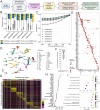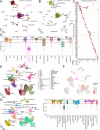Guided construction of single cell reference for human and mouse lung
- PMID: 37516747
- PMCID: PMC10387117
- DOI: 10.1038/s41467-023-40173-5
Guided construction of single cell reference for human and mouse lung
Abstract
Accurate cell type identification is a key and rate-limiting step in single-cell data analysis. Single-cell references with comprehensive cell types, reproducible and functionally validated cell identities, and common nomenclatures are much needed by the research community for automated cell type annotation, data integration, and data sharing. Here, we develop a computational pipeline utilizing the LungMAP CellCards as a dictionary to consolidate single-cell transcriptomic datasets of 104 human lungs and 17 mouse lung samples to construct LungMAP single-cell reference (CellRef) for both normal human and mouse lungs. CellRefs define 48 human and 40 mouse lung cell types catalogued from diverse anatomic locations and developmental time points. We demonstrate the accuracy and stability of LungMAP CellRefs and their utility for automated cell type annotation of both normal and diseased lungs using multiple independent methods and testing data. We develop user-friendly web interfaces for easy access and maximal utilization of the LungMAP CellRefs.
© 2023. The Author(s).
Conflict of interest statement
The authors declare no competing interests.
Figures








References
Publication types
MeSH terms
Grants and funding
- U01 HL148861/HL/NHLBI NIH HHS/United States
- P30DK117467/DK/NIDDK NIH HHS/United States
- U24 HL148865/HL/NHLBI NIH HHS/United States
- U01 HL148856/HL/NHLBI NIH HHS/United States
- U01 HL148867/HL/NHLBI NIH HHS/United States
- U01 HL122700/HL/NHLBI NIH HHS/United States
- U01 HL148860/HL/NHLBI NIH HHS/United States
- K08 HL163398/HL/NHLBI NIH HHS/United States
- R01HL153045/HL/NHLBI NIH HHS/United States
- R01 HL153045/HL/NHLBI NIH HHS/United States
- U01HL134745/HL/NHLBI NIH HHS/United States
- U01HL148856/HL/NHLBI NIH HHS/United States
- U01 HL122642/HL/NHLBI NIH HHS/United States
- P30 DK117467/DK/NIDDK NIH HHS/United States
- U01 HL134745/HL/NHLBI NIH HHS/United States
- U01HL122642/HL/NHLBI NIH HHS/United States
- U01 HL148857/HL/NHLBI NIH HHS/United States
LinkOut - more resources
Full Text Sources
Other Literature Sources

